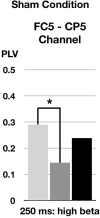Interhemispheric and Intrahemispheric Connectivity From the Left Pars Opercularis Within the Language Network Is Modulated by Transcranial Stimulation in Healthy Subjects
- PMID: 32256324
- PMCID: PMC7090226
- DOI: 10.3389/fnhum.2020.00063
Interhemispheric and Intrahemispheric Connectivity From the Left Pars Opercularis Within the Language Network Is Modulated by Transcranial Stimulation in Healthy Subjects
Erratum in
-
Corrigendum: Interhemispheric and Intrahemispheric Connectivity From the Left Pars Opercularis Within the Language Network Is Modulated by Transcranial Stimulation in Healthy Subjects.Front Hum Neurosci. 2020 Jul 14;14:249. doi: 10.3389/fnhum.2020.00249. eCollection 2020. Front Hum Neurosci. 2020. PMID: 32760262 Free PMC article.
Abstract
Neural activity related to language can be modulated within widespread networks following learning or in response to disruption-including the experimental application of noninvasive brain stimulation. However, the spatiotemporal characteristics of such modulation remain insufficiently explored. The present study combined transcranial magnetic stimulation (TMS) and electroencephalography (EEG) to explore the modulation of activity across the language network following continuous theta-burst stimulation (cTBS) of the left pars opercularis. In 10 healthy subjects (21 ± 2 years old, four females), neuronavigated cTBS was delivered over the left pars opercularis of the frontal operculum (part of the traditional Broca's area) at 80% of active motor threshold (AMT) stimulation intensity. Real cTBS and sham cTBS were performed in two different visits separated by at least 48 h. Before, immediately, and 10 min after cTBS, 30 single pulses of TMS were delivered to the left pars opercularis at 80% of the resting motor threshold (RMT), whereas EEG was simultaneously recorded. We examined the cTBS-induced modulation of phase locking values (PLVs) between the TMS-evoked potentials (TEPs) recorded over the pars opercularis and those recorded over its right-hemispheric homolog area, the left supramarginal area, and the left superior temporal area in different EEG frequency bands and different time windows following cTBS. cTBS to the left pars opercularis induced within the gamma band: (1) a significant increase in TEP phase synchronization between the left and right pars opercularis at an early time window (250-350 ms) following cTBS; and (2) significantly increased PLV with the left supramarginal area and the left superior temporal area at a later time window (600-700 ms). In the theta and delta band, cTBS to the left pars opercularis induced significantly increased phase synchronization of TEPs between the left pars opercularis and the posterior left hemispheric language areas at a late time window. In sham condition, there was a significant decrease in TEP phase synchronization of the high beta band between left pars opercularis and left superior temporal area at 200-300 ms. These results contribute to characterize the dynamics of the language network and may have implications in the development of noninvasive stimulation protocols to promote the language rehabilitation in aphasia patients.
Keywords: TMS-evoked potentials; continuous theta-burst stimulation; gamma band; noninvasive brain stimulation; phase synchronization.
Copyright © 2020 Yoo, Vernet, Kim, Brem, Bashir, Ifert-Miller, Im, Eldaief and Pascual-Leone.
Figures




Similar articles
-
Effects of continuous theta burst stimulation on contralateral primary motor cortex: a concurrent TMS-EEG study.J Neurophysiol. 2024 Nov 1;132(5):1530-1540. doi: 10.1152/jn.00320.2024. Epub 2024 Oct 23. J Neurophysiol. 2024. PMID: 39441211 Clinical Trial.
-
Corrigendum: Interhemispheric and Intrahemispheric Connectivity From the Left Pars Opercularis Within the Language Network Is Modulated by Transcranial Stimulation in Healthy Subjects.Front Hum Neurosci. 2020 Jul 14;14:249. doi: 10.3389/fnhum.2020.00249. eCollection 2020. Front Hum Neurosci. 2020. PMID: 32760262 Free PMC article.
-
Insights on the neural basis of motor plasticity induced by theta burst stimulation from TMS-EEG.Eur J Neurosci. 2013 Feb;37(4):598-606. doi: 10.1111/ejn.12069. Epub 2012 Nov 28. Eur J Neurosci. 2013. PMID: 23190020 Free PMC article.
-
Continuous theta-burst stimulation over the left posterior inferior frontal gyrus induced compensatory plasticity in the language network.Front Neurol. 2022 Sep 14;13:950718. doi: 10.3389/fneur.2022.950718. eCollection 2022. Front Neurol. 2022. PMID: 36188373 Free PMC article.
-
Electroencephalogram (EEG) With or Without Transcranial Magnetic Stimulation (TMS) as Biomarkers for Post-stroke Recovery: A Narrative Review.Front Neurol. 2022 Feb 22;13:827866. doi: 10.3389/fneur.2022.827866. eCollection 2022. Front Neurol. 2022. PMID: 35273559 Free PMC article. Review.
Cited by
-
Systemic Review on Transcranial Electrical Stimulation Parameters and EEG/fNIRS Features for Brain Diseases.Front Neurosci. 2021 Mar 26;15:629323. doi: 10.3389/fnins.2021.629323. eCollection 2021. Front Neurosci. 2021. PMID: 33841079 Free PMC article. Review.
-
Continuous theta burst stimulation-induced suppression of the right fronto-thalamic-cerebellar circuit accompanies improvement in language performance in poststroke aphasia: A resting-state fMRI study.Front Aging Neurosci. 2023 Jan 12;14:1079023. doi: 10.3389/fnagi.2022.1079023. eCollection 2022. Front Aging Neurosci. 2023. PMID: 36711202 Free PMC article.
References
Grants and funding
LinkOut - more resources
Full Text Sources
Miscellaneous

